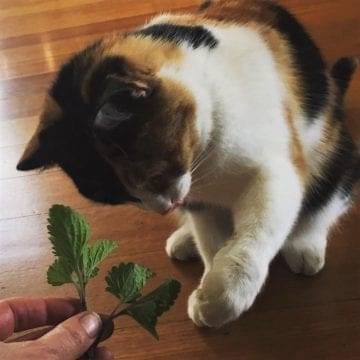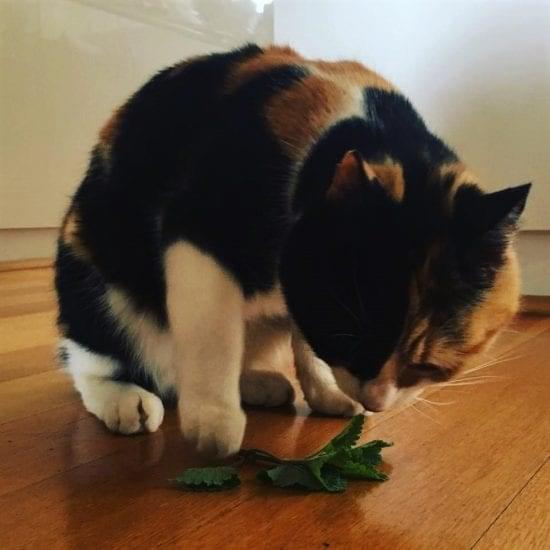Catnip and Cats
by Animal Expert Jacqueline Zakharia
Catnip (Nepeta cataria) is a member of the mint family and is easily available and grown in the garden or in pots. It likes full sun and rich moist soil.
Catnip contains essential oils, tannins, vitamin C and vitamin E as well as flavonoids, magnesium and manganese.
One of its particular uses is as a sedative to nearly all animals. Catnip’s sedative qualities are most particularly noticeable in cats, and after its use, a cat may appear euphoric. This is not seen in other animals.
Cats will typically sniff, eat and roll in the herb and it is a harmless substance to use. It should be noted that not all cats will have this reaction, but most will.
Catnip as a Nervine

According to Dr Kidd, Catnip can be also be used externally as a poultice on sores and wounds. He goes on to say that if you are wanting to use it for its calming effects, simply toss a handful near your cat and wait till the euphoria subsides, and I love his suggestion of using it intermittently on long trips when a cat may feel anxious.
Anitra Frazier suggests using catnip during vet examinations as she has seen Dr Rowan, a cat specialist, routinely dispense the herb. He would give catnip to distract cats during an examination, so when their feline patients returned they were always happy to see Dr Rowan! Anitra also suggests making sure your catnip supply in a secure place as cats will get into containers and places they would not normally go just to get to their favorite herb. Always keep your catnip in sealed, labeled containers away from light to preserve the natural flavonoids.
Greg Tilford suggests dropping a few leaves into your cat’s water, especially if there is stress in the household such the arrival of another cat! He also suggests you can feed it to your cat dried onto the food at a dose of 1/8 to ½ teaspoon per pound (half a kilo) of food fed.
It can be used fresh or dried chopped herbs, as a tincture or water infusion. It can also be stuffed in a catnip toy.
Cautions
There are little significant side effects or precautions although if purchasing dried catnip make sure you purchase the organic variety. However, Greg Tilford does mention to use sparingly on pregnant animals just as a precaution.
Disclaimer
This article is not intended as a substitution for qualified veterinary care. Although I am qualified small animal herbalist, I have a great relationship with my local vet clinic and do seek advice and diagnoses of my own pets and rescues. Please make use of your trusted vet for direction.
References
Frazier, A 1990, The New Natural Cat, Penguin, USA.
Kidd, R 2000, Herbal Cat Care, Storey Publishing, USA.
Tilford, G 2009, Herbs for Pets, 1-5 Publishing, USA.
Our Cat Model

Sue’s note: Remember that all life forms deserve respect. Although Lady Penelope and her kittens were lucky enough to find a loving home, most cats do not share her good fortune. Female cats go into “heat” every 2 or 3 weeks. They can get pregnant right after giving birth. Showing responsibility for our animal friends is a great way to prove to them just how much you love them. Herbal medicine is just one way to look after their mental and physical health. Always spay and neuter your pets.
Author Bio

Jacqueline is a herbal medicine practitioner of dogs and cats, has worked in animal rescue for 11 years on a volunteer basis and has a Bachelor of Social Science (Politics and Sociology), qualified counselor (AIPC), is a Reiki Master (Usui system) and an Australian Bush Flower Essence Practitioner of animals for 6 years.
Jacqueline lives on a farm in a temperate rain forest in Victoria, Australia with her husband and menagerie of rescue animals. Jacqueline is passionate about herbs and animal welfare.
For further information on Jacqueline please visit her FB pages Jac Zak Animal Remedies and Jac Zak Otway Herbals or email her [email protected].






